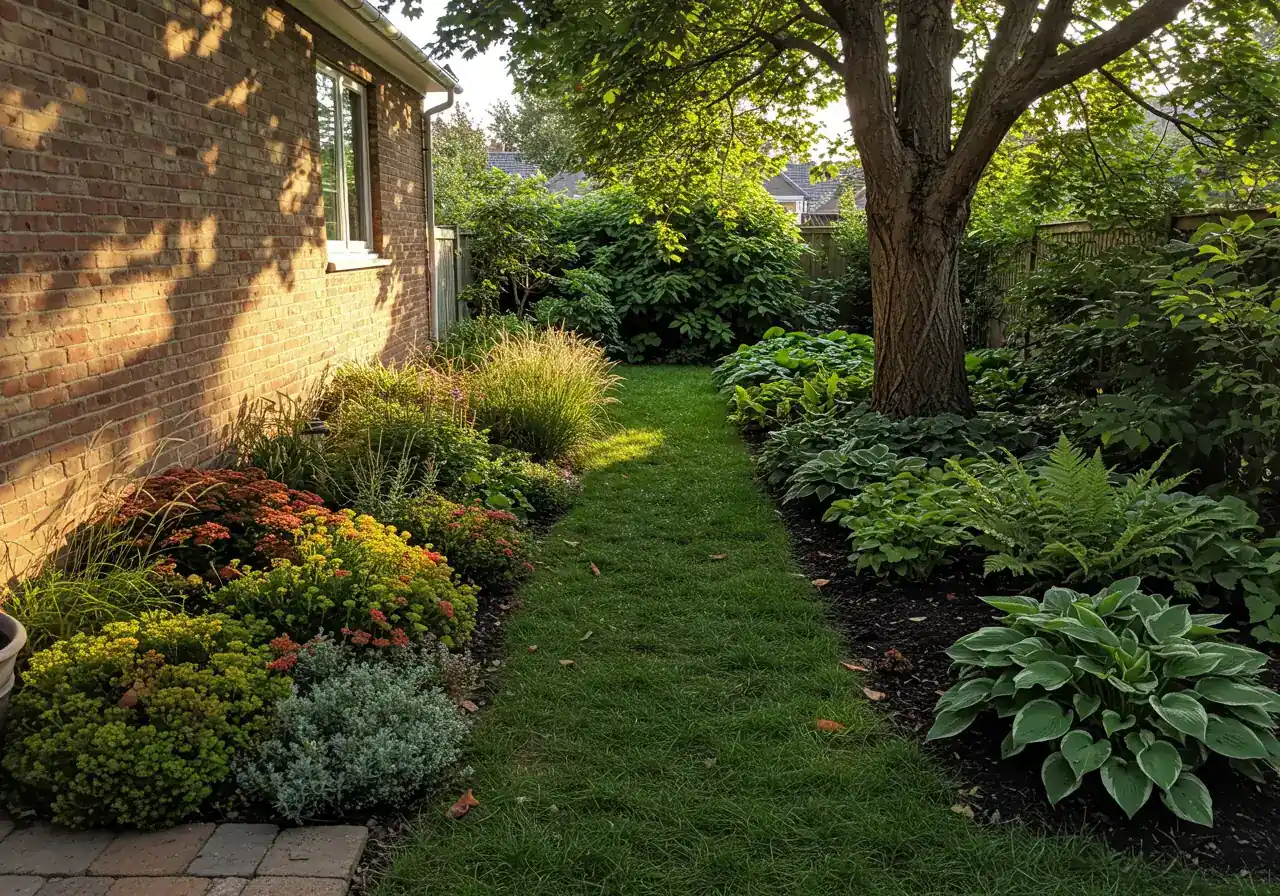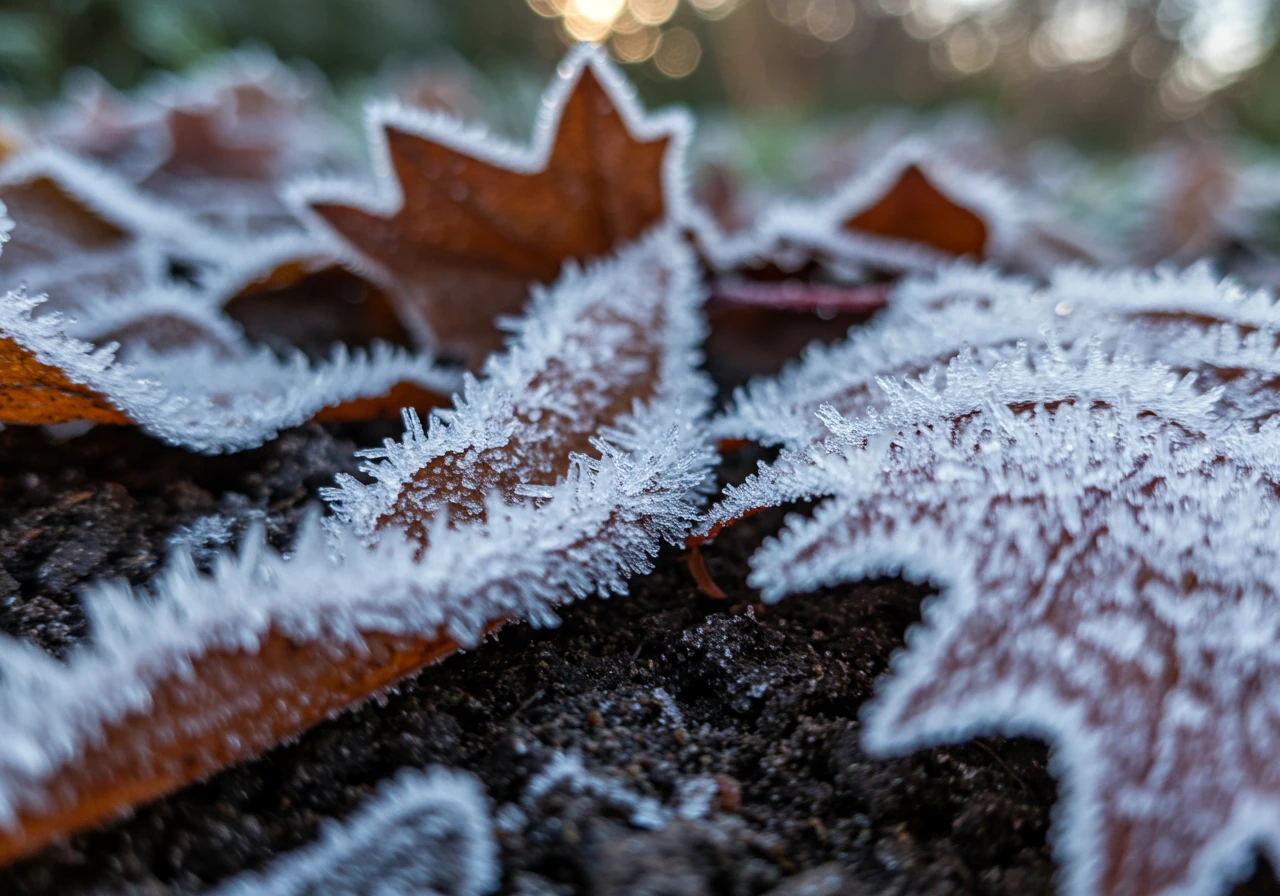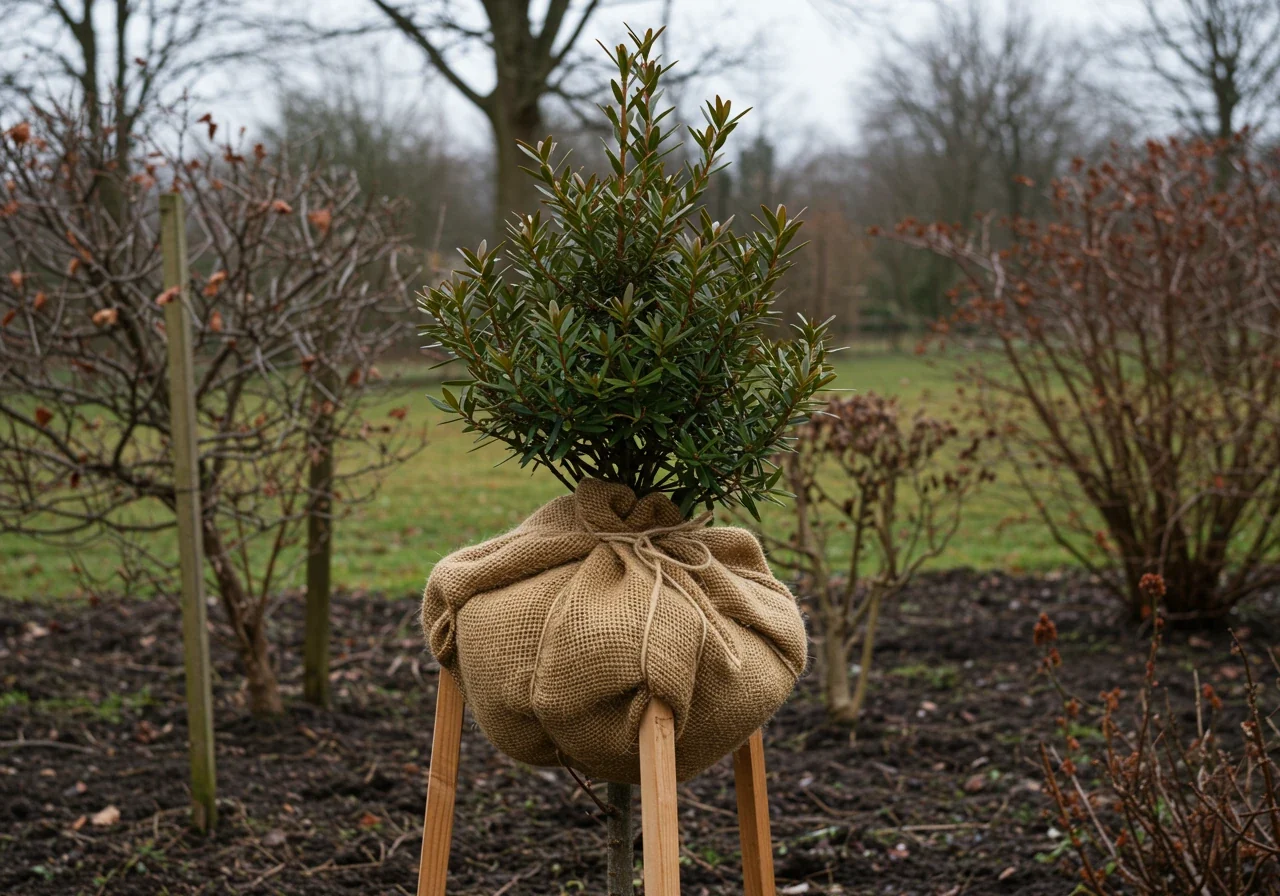Winchester Garden Microclimates: Fall Prep Saves Plants
Quick Summary: Fall Garden Prep & Microclimates
- Microclimates Matter: Your yard has unique mini-weather zones (sunny, shady, windy, damp) affecting plant survival.
- Map Your Yard: Observe sun, wind, water, and frost patterns to understand these zones.
- Tailor Fall Tasks: Adjust cleanup, watering, and mulching based on each microclimate's needs.
- Protect Vulnerable Plants: Use mulch, burlap wraps, or shelter for sensitive species, especially in exposed areas.
- Act Before Winter: Complete key tasks like cleanup, mulching, and protection before the ground freezes and snow arrives.
Need help getting your garden winter-ready? Request a quote today!
Introduction: Winter is Coming (Especially to Your Winchester Garden!)
Okay, Winchester green thumbs, brace yourselves – winter *is* coming, and it’s got its frosty eye set squarely on our gardens! While the vibrant fall colours across the Ottawa region, from here clear out to Greely, are undeniably spectacular, that definite chill in the air is Mother Nature’s not-so-subtle hint. It’s time for some serious fall gardening TLC before the snow flies.
Now, you might think your patch of earth faces the freeze just like everyone else's, but have you ever noticed little quirks in your own yard? Maybe the landscaping near the south-facing wall stays a bit warmer, or that windy corner by the shed seems extra harsh? Welcome to the fascinating world of microclimates! These are tiny, hyper-local weather pockets, unique to specific spots on your property. Understanding your garden's specific sunny spots, wind tunnels, and frost pockets is crucial for smart fall prep – think targeted mulching, deciding which rose bush needs extra burlap, or knowing where frost might hit first. Getting cozy with your microclimates now means a happier, healthier garden ready to burst forth next spring. Let's dive into how you can tackle winter prep like a pro!
What in the Wacky Weather is a Microclimate? (And Why Winchester Yards Have So Many)

Okay, let's break it down! Think of a microclimate as a tiny weather bubble existing right in your own yard, different from the general Ottawa forecast or even what your neighbour experiences down the street. It's like your property has its own mini-weather system, influenced by all sorts of hyper-local factors. Silly, right? But totally true!
So, what creates these wacky little weather pockets? Lots of things!
- Sunlight & Shade: That spot baking against your south-facing brick wall is way warmer than the perpetually shady north side under your big maple tree. Hardscaping like patios and driveways absorbs and radiates heat, creating warmer zones.
- Wind: Fences, hedges, your house, and even decorative structures can block wind, creating sheltered spots. Conversely, gaps between buildings or open stretches can create wind tunnels. Thinking about adding structure? Even stylish additions can influence your yard's mini-climate, something to consider alongside Winchester pergola plans boost home value.
- Elevation & Slope: Even slight changes in your yard's topography matter. Cold air settles in low spots, making them prone to frost pockets, while slopes affect water runoff and sun exposure.
- Structures: Your house, garage, sheds, and fences all cast shadows, block wind, and radiate heat differently.
- Soil Type: Different soils retain heat and moisture differently. Winchester often features heavier clay soil, which warms up slower in spring but holds moisture longer than sandy soils. Understanding this is key, especially when thinking about Winchester spring garden spacing clay soil. Good soil preparation helps manage these characteristics.
- Water: Ponds or even nearby ditches can moderate temperatures slightly and increase humidity locally.
- Plant Cover: Dense landscaping, mature trees, and shrubbery create shade, humidity, and reduce wind.
Now, why might Winchester yards seem to have so many microclimates compared to, say, a newer development in Barrhaven? Winchester often boasts larger properties with more established, diverse landscaping – mature trees, varied garden beds, maybe a mix of open lawn and sheltered corners. This variety naturally creates more distinct mini-zones. Newer suburbs often have more uniform lot sizes, younger trees, and houses built closer together, leading to slightly less variation within individual yards (though they still have microclimates!).
Understanding these zones is your secret weapon for successful gardening. A tender perennial might thrive near that warm house foundation but perish in an exposed, frosty corner. Knowing these spots helps immensely with choosing the right plants and deciding where specific planting should occur. It informs everything from where to place delicate flowers to how to plan your overall layout – a crucial part of smart Winchester garden design your oasis awaits. Paying attention to these zones can also help you anticipate problems, like fungal issues in damp, shady spots, which relates to maintaining good Winchester plant healthcare program summer issues.
Dealing with the unique challenges and opportunities presented by your yard's specific microclimates can sometimes feel like a puzzle. Whether it's targeted mulching, strategic planting, or specialized cleanup for problem areas identified through understanding microclimates, sometimes getting professional help makes all the difference. Explore options like a dedicated Winchester yard cleanup service or other landscaping services to keep every corner of your yard happy. We also offer services nearby, like property cleanup service in Marionville and Metcalfe property cleanup service.
Become a Microclimate Detective: Mapping Your Winchester (or Greely, or Metcalfe!) Yard

Alright, grab your metaphorical magnifying glass and deerstalker hat (or just your phone and a notepad!) – it’s time to become a microclimate detective right in your own backyard. Whether you're tending a garden in Winchester, Greely, or out near Metcalfe, understanding these mini weather zones is key to smarter gardening. It's easier than you think, mostly involving some patient observation. Let's get sleuthing!
Step 1: Be a Sun Stalker
Over a few different days (sunny and cloudy, if possible), take note of where the sun hits your yard and when.
- Where does the morning sun land first?
- Which spots get blasted by the intense afternoon sun? Note areas against south or west-facing walls – these are often much hotter.
- Where are the perpetually shady zones, maybe under large trees or on the north side of your house?
- Detective Tip: Knowing your sun exposure is crucial for successful planting. Sun-loving tomatoes won't be happy in deep shade, and delicate hostas will fry in baking afternoon sun. Proper material selection for plants is key.
Step 2: Listen to the Wind
On a breezy day, wander around your yard.
- Where does the wind feel strongest? Are there any corners that create a wind tunnel effect?
- Where are the calm, sheltered spots? Look behind fences, hedges, sheds, or the house itself.
- Detective Tip: Windy spots dry out soil faster and can damage fragile plants (windburn is real!). Sheltered spots are gold for plants needing protection.
Step 3: Follow the Water
After a good rain (or a thorough watering), see where the water goes.
- Are there low spots where water tends to puddle and linger? These damp areas might need different plant choices or improved drainage.
- Which areas dry out the quickest? These might be sloped, sandy, or exposed to sun and wind, requiring more frequent watering or heavier mulching.
- Detective Tip: Water patterns influence soil moisture, a huge factor in plant health. Persistent dampness, especially with leaf litter, might need attention from an Ottawa garden clean up service to prevent issues. These principles apply broadly, even if you need a garden clean up service in Marionville or a city garden clean up service.
Step 4: Look for Frost (Seasonally)
In early spring or late fall, get outside on a chilly morning just after sunrise.
- Where does the frost melt last? These are likely your frost pockets – often low-lying areas where cold air settles.
- Detective Tip: Identifying frost pockets is vital for protecting tender perennials or knowing where not to place frost-sensitive annuals too early in spring.
Step 5: Draw Your Map!
Now, sketch a rough map of your yard. Include major features: your house, garage, large trees, patios, garden beds, fences. Mark down your observations using symbols or notes:
- "Hot Spot - Afternoon Sun"
- "Windy Corner"
- "Stays Damp"
- "Frost Pocket"
- "Morning Sun Only"
This simple map is now your secret weapon! Use it to choose the right plants for the right place, decide where to add protective mulching, and plan future landscaping projects. It makes tasks like targeted regular garden maintenance much more effective, ensuring each zone gets the care it needs. If you're planning new beds or features, this map is invaluable; consider consulting with professionals for complex projects or professional garden install services to bring your vision to life based on your findings. Having trouble with a particularly tricky spot identified on your map? Sometimes a focused cleanup can make a big difference, and a dedicated Winchester yard cleanup service or Ottawa yard cleanup service can help tackle problem areas. Before engaging any professional help, it's always a good idea to understand the process and expectations, so take a moment to review our terms and conditions. Happy mapping!
Fall Prep Power-Up: Tailoring Tasks to Your Tiny Climates
Okay, microclimate detectives! You’ve stalked the sun, chased the wind, and mapped your yard's little weather quirks. Now it’s time to put that intel to work with some Fall Prep Power-Ups. Instead of a one-size-fits-all approach, let's tailor your autumn gardening tasks to those unique zones you discovered, whether you're tending beds in Osgoode or nurturing shrubs in Russell. Think of it as giving each part of your yard exactly what it needs to face the Ottawa winter like a champ!

Adapting Your Autumn Action Plan:
- Cleanup Crew Adjustments: That damp, shady corner under the big maple? It needs a meticulous clean up. Lingering leaves there can trap moisture, inviting fungal diseases or becoming a cozy (but unwanted) slug hotel over winter. Be extra thorough! Contrast this with a dry, windy spot where leaves might blow away naturally or pose less of a rot risk. General leaf litter across the lawn and beds still needs attention, of course. If certain areas feel overwhelming, remember that targeted help is available, from a dedicated Ottawa garden clean up service for specific beds to a more comprehensive property clean up for the whole shebang. Even urban dwellers face these varied needs, which is why a specialized city garden clean up service or broader city property cleanup service can be invaluable.
- Water Wisely: Plants still need water in the fall, especially evergreens, but how much depends on the microclimate. Hot, sunny spots or windy corners dry out faster and may need a final deep watering before the ground freezes solid. Conversely, perpetually damp, shady areas might need very little supplemental water – overwatering here can lead to root rot, especially as growth slows. Keep an eye on the soil moisture in each zone. Proper lawn care also involves appropriate fall watering.
- Mulch Magic: Mulching is your garden's winter blanket, but not every bed needs the same thickness. Effective mulching and edging define beds and protect plants.
- Frost Pockets & Exposed Areas: Be generous here! Apply a thicker layer (3-4 inches) of mulch (like shredded bark or straw) after the ground starts to cool but before it freezes hard. This insulates the soil, preventing harmful freeze-thaw cycles that can heave plants out of the ground.
- Warm Spots (e.g., near foundations): You might use slightly less mulch here, especially around plants that dislike excessive moisture near their crowns.
- Damp Areas: Ensure mulch isn't packed right against plant stems to allow air circulation and prevent rot. Good soil preparation earlier in the season helps ensure drainage, making mulching more effective.
- Planting & Protecting: Planting spring bulbs or garlic this fall? Use your map! They generally need well-drained soil and adequate sun (check bulb specifics). Avoid planting bulbs in known soggy spots. For tender perennials or shrubs in windy corners or frost pockets, consider extra protection like burlap wraps or rose cones *after* they’ve gone dormant but before the really harsh weather hits. That sunny spot near the house might offer enough passive protection for slightly less hardy plants. Consider professional garden installation services if you're adding new beds.
Microclimate Fall Prep Cheat Sheet:
Here’s a quick guide:
| Microclimate Zone | Key Characteristic | Tailored Fall Action |
|---|---|---|
| Hot & Sunny | Bakes in sun, dries quickly | Check for late-season watering needs. Mulch well to conserve moisture. Less winter protection usually needed unless plants are borderline hardy. |
| Shady & Damp | Limited sun, stays moist | Prioritize thorough leaf clean up to prevent disease/pests. Avoid overwatering. Use slightly less mulch, pulling it back from plant crowns. |
| Windy Corner | Exposed, dries out, windburn risk | Water deeply before freeze-up, especially evergreens. Apply thicker mulch. Provide windbreaks (burlap) for sensitive plants. |
| Frost Pocket | Low-lying, collects cold air | Avoid planting frost-sensitive species here. Apply generous mulch *after* ground cools. Provide extra protection (cones, wraps) for vulnerable plants. |
| Sheltered & Warm | Protected, near structures | Often the safest spot for borderline hardy plants. Standard mulching usually sufficient. Monitor for pests seeking shelter. |
By paying attention to these mini-zones, your fall landscaping efforts become much more effective. It’s about working smarter, not harder! And if life gets busy or some areas require more muscle than you planned, remember professional teams offering an Ottawa property cleanup service or a city yard cleanup service are ready to lend a hand. We respect your personal information when you reach out; you can always review our commitment to safeguarding your data in our privacy policy. Find us on Google: Clean Yards on Google.
Winter Protection Methods Compared
Organic Mulch (Shredded Bark, Straw, Leaves)
Pros: Insulates soil against freeze-thaw, conserves moisture, suppresses weeds, improves soil over time.
Cons: Can harbor slugs if too thick in damp areas, needs replenishment.
Best For: Perennials, base of shrubs, insulating root zones.
Burlap Wrap
Pros: Protects against windburn and sunscald, especially for evergreens. Allows air circulation.
Cons: Can be time-consuming to apply, may need stakes for support.
Best For: Tender evergreens (cedars, dwarf spruce), some hydrangeas, young trees in exposed locations.
Styrofoam Rose Cones
Pros: Provides good insulation against cold, relatively easy to place.
Cons: Needs ventilation holes to prevent moisture buildup, can blow away if not secured, less aesthetically pleasing.
Best For: Hybrid tea roses, other compact tender shrubs.
Saving Your Star Players: Plant Protection Secrets for Ottawa Winters

Okay, let's talk about playing favourites – with our plants, that is! While many tough cookies in our gardens scoff at Ottawa winters, some of our prized specimens need a little extra TLC to make it through the deep freeze and snow. Think of it as tucking them in with a cozy winter blanket (or sometimes, a rather fetching burlap coat!). Whether you're gardening in leafy Manotick or closer to the city centre, protecting your vulnerable stars is key to a glorious spring reunion.
Here are the secrets to saving your sensitive plants:
- Mulch More, Worry Less: We touched on mulching before, but it’s crucial for protection. A good 3-4 inch layer of organic mulch (like shredded bark, straw, or even chopped leaves from your clean up) applied *after* the ground starts to cool down is vital.
- Why? It insulates the soil, preventing the damaging freeze-thaw cycles that can heave roots right out of the ground (rude!).
- Microclimate Link: Be extra generous in those identified frost pockets or exposed beds. For plants sensitive to crown rot (like some perennials), keep the mulch slightly away from the base of the stem. Getting the underlying soil right helps too, think about good soil preparation from earlier seasons.
- Wrap It Up!: Some plants need more than a blanket; they need a coat!
- Who Needs It? Tender hybrid tea roses, some hydrangeas, and young or sensitive evergreens (like certain cedars or Dwarf Alberta Spruce) prone to winter windburn or sunscald.
- How? Use burlap! Wrap it loosely around the plant, securing it with twine. For roses, you can create a cylinder of burlap or snow fence and fill it loosely with dry leaves or straw *after* the plant is dormant and the ground is cold. Avoid plastic wraps – they trap moisture and can cause more harm than good. Check out our general about us page to learn more about our approach.
- Microclimate Link: Wrapping is especially important in those windy corners or spots that get harsh afternoon sun reflecting off snow.
- Shelter Skelter: Sometimes, a physical barrier is the best defense.
- Rose Cones: Styrofoam rose cones can be placed over dormant roses (after trimming them back appropriately). Ensure there's ventilation (poke holes!) to prevent moisture buildup. Weight them down so they don’t blow away!
- Container Care: Bring potted tender perennials or small shrubs into an unheated garage or shed. If they must stay outside, group containers together in a sheltered spot (remember those warm zones near the house from your microclimate map?) and mulch them heavily or wrap the pots.
- Temporary Windbreaks: For rows of vulnerable shrubs, staking burlap sheets to create a temporary fence on the windward side can make a huge difference.
Proper fall cleanup is the first step before applying protection. If tackling piles of leaves feels daunting, remember help is available. Options range from a focused Ottawa yard cleanup service to broader assistance like a city property cleanup service for larger tasks. Even city dwellers benefit from tailored care, perhaps needing a specific city yard cleanup service or ongoing support via a city garden maintenance service. When you reach out for quotes or services, rest assured your details are handled according to our privacy policy. We also value your input on our quoting process; feel free to share your thoughts through our estimate feedback form. A little protection now means less heartbreak and more beauty come spring!
Effectiveness of Winter Protection Methods (Estimated)
Key Insights: Your Winchester Fall Prep Cheat Sheet
Okay, Winchester friends, feeling a little overwhelmed by all that fall gardening advice? Don't sweat it! Think of this as your quick-reference cheat sheet to tackle autumn landscaping prep like a seasoned pro. Here are the key takeaways to get your yard ready for its long winter nap:
- Play Microclimate Detective: Remember those unique sunny, shady, windy, or damp spots in your yard? Knowing these mini-zones is your secret weapon! They dictate where frost hits first, where soil dries fastest, and which plants need extra coddling. Map 'em out!
- Tailor Your Tidy-Up: Don't just rake wildly! Give damp, shady areas a *super* thorough leaf cleanup to prevent mould and pests overwintering. Windy spots might need less leaf patrol. This targeted approach works wonders everywhere, from downtown Ottawa yards to larger lots needing a specific Metcalfe property cleanup service or Marionville yard cleanup service.
- Mulch is Your BFF (But Apply it Smartly): A cozy blanket of mulch protects plant roots from harsh freeze-thaw cycles. Apply 3-4 inches *after* the ground cools but *before* it freezes solid. Use more in exposed zones and frost pockets, and maybe a bit less in damp areas, pulling it away from plant stems. Proper mulching and edging makes a huge difference visually and functionally.
- Protect the Vulnerable Stars: Got tender roses, young evergreens, or borderline hardy perennials? Give them extra love! Use burlap wraps, rose cones, or move potted plants to shelter. Choosing the right protection depends on the plant and the spot – smart material selection ensures you use the most effective barrier against winter woes.
- Plan, Don't Panic: Break down the tasks. Know what needs doing where, based on your microclimate map. If the job feels too big, don't hesitate to call in reinforcements. Getting clear quotes helps manage expectations, and providing estimate feedback ensures you get the service you need.
Stick to these points, and trust us, your garden will definitely send you a big 'thank you' with beautiful blooms next spring! Happy prepping!
Fall Prep Timeline: Key Stages
Early Fall (Late Sept - Early Oct)
Remove diseased plants promptly. Assess summer damage. Plan bulb planting locations. Start light cleanup of falling leaves.
Mid Fall (Mid - Late Oct)
Major leaf cleanup begins. Plant spring bulbs & garlic. Cut back specific perennials. Give lawns a final fertilization if needed.
Late Fall (Late Oct - Mid Nov)
Apply winter mulch after ground cools. Wrap sensitive shrubs/trees. Empty & store pots. Deep water evergreens before freeze-up.
Before Snow (Mid - Late Nov)
Final lawn mow (slightly shorter). Drain & store hoses/irrigation. Clean & store tools. Ensure protection measures (wraps, cones) are secure.
Frequently Asked Questions (FAQs) for Ottawa Gardeners
Ah, the eternal question! Ideally, you start gradually throughout the fall. Tackle diseased plants right away to prevent problems from spreading. Major leaf raking and mulching are best done after most leaves have fallen but *before* the first permanent snowfall – usually late October into November for the Ottawa area, whether you're in Winchester or closer to Nepean. Waiting too long means battling frozen ground or working in truly miserable weather. Procrastinators, we see you, but your back will definitely thank you for starting a bit earlier!
Yes, absolutely! Fall is actually a great time for lawn repair. The soil is still warm enough for seed germination, but the cooler air and increased moisture help new grass establish. You can overseed thin patches or repair bare spots. Just rake the areas well to loosen the soil, add a thin layer of topsoil or compost, sprinkle your grass seed evenly, and keep it lightly watered until the new grass sprouts. For larger damaged areas or if you want quicker, more guaranteed results, considering professional sod installation might be your best bet for a lush, green lawn next spring.
We feel your pain – leaf season in Ottawa can be intense! While leaving some leaf litter in your garden beds isn't the worst thing (it can act as a natural mulch and shelter for beneficial critters), you absolutely want to remove thick layers, especially from your lawn. Matted leaves block sunlight and air circulation, which can smother your grass and encourage diseases like snow mold over winter. A good compromise? Use a mulching mower to chop up leaves on the lawn – they'll break down and feed the grass. You can also rake leaves onto garden beds as mulch, just don't pile them too deeply around plant stems. If the sheer volume is just too much, remember help is available. Whether you need a specific Metcalfe garden clean up service or assistance elsewhere, professional crews can make those leaf mountains disappear.
Good question! Let's hit the high points for essential fall prep:
- Clean Up Garden Debris: Get rid of dead annual flowers and any diseased perennial leaves. This reduces places for pests and diseases to hide over winter.
- Protect Vulnerable Plants: Wrap tender shrubs (like certain cedars or hybrid tea roses) with burlap, especially if they're in exposed, windy spots. Apply a good layer of mulch around the base of perennials and roses *after* the ground has started to cool down.
- Water Wisely: Give your evergreen trees and shrubs a final deep watering before the ground freezes solid. They continue to lose moisture through their needles/leaves during winter.
- Tool & Equipment Care: Drain and store garden hoses. Clean off shovels, pruners, and other tools before storing them for winter. Empty and clean pots that might crack in the freeze, or move them into a shed or garage.
- Final Lawn Mow: Cut your grass one last time, maybe a touch shorter than usual, to help prevent snow mold.
That post-annual emptiness is real! Don't despair, you have options. Fall is the perfect time to plant spring-blooming bulbs like tulips, daffodils, and crocuses – think of it as burying treasure for next spring! Adding a fresh layer of attractive mulch (like shredded bark) not only protects the soil but also gives the beds a tidy, finished look. For some immediate, albeit temporary, colour, you could pop in some cold-hardy ornamental kale or cabbage. Also, use this time to think about next year's landscaping – could you add some small shrubs or perennials that offer winter interest with their structure or bark? Looking at photos of inspiring garden transformations can spark some great ideas for creating beauty in every season. Check out reputable local resources like the Ottawa Horticultural Society or the Master Gardeners of Ottawa-Carleton for ideas.
Definitely not cheating – it's smart planning! Fall cleanup, especially on larger properties like those often found around Metcalfe or Greely, can be a huge amount of work. Your time, energy, and back muscles are valuable resources! If the thought of endless raking, cutting back perennials, hauling mulch, and winterizing everything makes you want to hide indoors until spring, calling in professionals is a fantastic solution. Many companies offer tailored fall cleanup packages. Whether you need a comprehensive Metcalfe yard cleanup service or just a hand with the heaviest tasks, don't hesitate to explore your options. Feel free to get in touch with us to chat about how we can help lighten your autumn workload. You can also check city resources for composting info: City of Ottawa - Gardening.
Conclusion: Tuck Your Garden In Tight for a Winchester Winter
Phew! We've journeyed through the quirky world of microclimates, played detective in our own backyards, and learned how to tailor our fall gardening chores like pros. From the specific needs of a shady corner in Winchester to a windy spot out near Russell, understanding these mini-zones is your secret weapon against the harsh Ottawa winter. By mapping your yard, adjusting your clean up approach, applying mulch strategically, and protecting those vulnerable plant stars, you're not just tidying up – you're investing in a spectacular spring comeback! Think of it as putting your garden to bed properly so it wakes up refreshed and ready to bloom.
Putting this knowledge into action means less winter damage and more springtime smiles. Remember, a little extra effort now pays off big time later. If those leaf piles look more like mountains, or the thought of wrestling burlap in the cold isn't your idea of fun, don't sweat it! Let us lend a hand. Whether you need a thorough fall yard cleanup service in Winchester (Winchester Yard Cleanup Service) or help with protective mulching in Greely, our team is ready to tuck your garden in tight. Give us a call, and let’s get your landscaping services needs covered and ready to dream sweetly through the snow!

